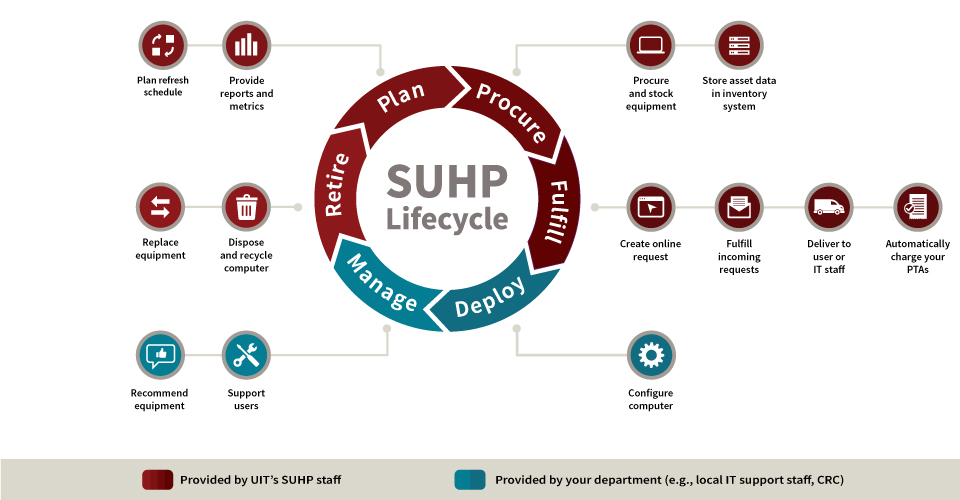The Stanford University Hardware Program (SUHP) relieves your organization of the administrative burden of purchasing new work computers and standard accessories for faculty and staff.
Under the program, UIT manages procurement and inventory, and quickly and securely gets the equipment to your IT support team for configuration and deployment. With a consistent and efficient procurement process, SUHP can help reduce turnaround time and costs. Additionally, you can customize particular aspects of the service to meet your local needs.
Included Support

SUHP Lifecycle
Plan (provided by SUHP staff)
plan refresh schedule
provide reports and metrics
Procure (provided by SUHP staff)
provide and stock equipment
store asset data in inventory system
Fulfill (provided by SUHP staff)
create online request
fulfill incoming requests
deliver to user or IT staff
automatically charge your PTAs
Deploy (provided by your department)
configure computer
Manage (provided by your department)
recommend equipment
support users
Retire (provided by SUHP staff)
replace equipment
dispose and recycle computer
Click image to enlarge
From order to deployment, our team is here to help guide the process. Through the service, we:
- Manage procurement lifecycle (e.g., requests, procurement, inventory management) for primary computers and accessories requested by your department’s faculty and staff. We can also handle requests for secondary computers at your department’s discretion.1
- Specify recommended standard computer models and accessories (as specified by your department) for cost-effective pricing. Can also process requests for custom/non-standard equipment.2
- Maintain inventory of your standard equipment to ensure quick delivery.2
- Handle requests for new and replacement equipment, including lost, stolen, or damaged computers.
- Refresh equipment based on a schedule pre-determined by the department, or individual exceptions approved by the department.
- Include standard accessories: dock, monitor, keyboard and mouse, headset, and webcam.
- Relieve local staff from performing related procurement coordination and inventory activities for covered equipment. We also relieve local IT support staff from defining computer configurations for each individual request.
- Deliver consistent reporting and metrics that allow departments to predict and better forecast their budgets for new and replacement equipment.
1 Costs for equipment ordered through the program are not covered by the agreement and must be funded by a central account specified by the department or through individual accounts provided at the time of the request.
2 Pricing and deployment times vary with customized models. Departments pay the cost for the equipment ordered regardless of whether standard or customized model.
Note: The SUHP handles procurement, inventory, and delivery tasks. You still need your IT support team to configure, deploy, and maintain the equipment.
Designed for
All university schools, departments, and administrative units.
Requirements
Your organization must be part of Stanford University.
Rates
The monthly fee is $5.35 per computer.
Get started
Your organization representative starts by requesting a free consultation to discuss specific needs. We will create a draft agreement that includes equipment details and program costs for you to consider. We’ll work together to ensure the agreement meets your specific needs.
To get started, simply request a free consultation with our team. We’ll get back to you quickly to set up a meeting time and start building a draft agreement for your review.
Get help
For more information about the SUHP, contact our team by submitting a Help request.
See also
Check out the Hardware Program Learning Center for guides on how to get started with placing an order as a customer, or managing an order as a participating organization.
